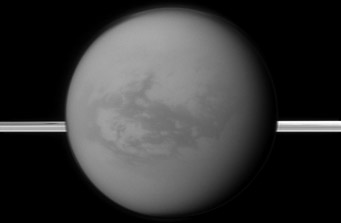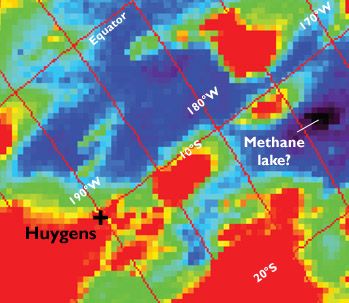Based on infrared images from the Cassini orbiter, small areas in the equatorial regions of Titan appear to contain lakes of liquid methane.

This infrared image from Cassini is looking toward the dark region of Titan called Shangri-La, east of the landing site of the Huygens probe. Saturn's rings lie in the distance.
NASA / JPL / Space Science Inst.
My vote for "Coolest Moon in the Solar System" goes to Saturn's Titan. A bit larger than Mercury, Titan has a crust of rock-hard water ice and an atmosphere denser than Earth's. The "air" around Titan is 95% nitrogen, but that's where any similarity to what we breathe ends. Almost all the rest is methane (CH4).
Sunlight is very good at transforming methane into ethane (C2H6) and a host of other hydrocarbon compounds, a.k.a. smog. (That explains why this moon's surface is masked from our view, at least in visible light.) Not so long ago, astronomers assumed that enough ethane has been cooked up in in Titan's atmosphere to create a global ocean at least 3 miles (5 km) deep.
But that's not the case at all! As first glimpsed by radar in the 1990, then later by infrared imaging, and most recently by NASA's Cassini orbiter, the surface of Titan is mostly dry land, er, ice. The spacecraft did find a cluster of hydrocarbon lakes at its poles, but the moon's midsection appeared to consist of vast tracts of dune fields. There must be some liquid methane near the equator — in 2005 the Huygens landed splutted onto a methane-moistened patch at latitude 10° south — but theorists have reasoned that any tropical methane should be quickly whisked toward the cooler poles and dumped into the reservoirs there.

Titan's atmospheric haze is transparent at the near-infrared wavelength of 1.3 microns, which allowed the Cassini spacecraft to record surface reflectivity (here color coded from black to red) in the vicinity of the Huygens landing site. This view is about 600 miles (900 km) wide.
C. Griffith & others / Nature
Now researchers led by Caitlin Griffith (University of Arizona) have found evidence of puddled methane in Titan's equatorial region. As they describe in the June 14th issue of Nature, the suspect areas appear in views taken at several infrared wavelengths during close flybys between 2004 and 2008.
One oval feature, about 40 miles (60 km) long, lies about 500 miles (750 km) from the Huygens landing site. It's too dark to be a solid surface, which would reflect at least some infrared energy, or even solid particles floating atop liquid. The team concludes that it must be an exposure of liquid methane, one that's lacking the spectroscopic signature of liquid ethane seen the much larger Ontario Lacus near Titan's south pole.
Other features appear somewhat brighter in the infrared, suggesting that they're patches dampened by liquid methane a few inches deep. One of these is unusual in that it lies within a dune field. This hadn't been expected, though hollows sometimes become wet on similarly shaped sand dunes on Earth. "In essence," Griffith notes in a NASA press release, "Titan may have oases."
The existence of these tropical lakes has only deepened the mystery of where and how Titan generates its methane. They have to be replenished somehow, and hydrocarbons haven't rained down from the Titanian sky often enough to supply it. In fact, earlier studies show that the moon needs to generate some 50 million tons of methane each year to keep its atmosphere enriched at present-day levels. As Griffith and her colleagues conclude, "More observations are needed to determine whether this 4.5-billion-year-old moon is undergoing a specific recent flourish of geological activity."
Fortunately, NASA managers have agreed to fund the Cassini mission through at least September 2017, a few months after the next summer solstice in Saturn's northern hemisphere. The spacecraft just concluded a close brush Titan on June 6th, utilizing its radar imager while passing just 596 miles (959 km) away, and more close flybys have been scheduled in July, September, and November (twice).
 4
4
Comments
Bruce
June 21, 2012 at 7:28 pm
Ah, the tropical oases of Titan. Sounds almost idyllic, until you learn the facts. In reality, Titan seems more like an environmentalist’s worst nightmare, or maybe one of the frozen levels of a mythical Hell. Being ever optimistic though, I can see great potential usefulness in Titan. In it’s abundant hydrocarbons I see “black gold, Texas tea” on ice, a possible fuel source for use in the outer solar system and beyond. Someday robotic tools from this world may help mankind reap benefits from Titan's oily seas.
You must be logged in to post a comment.
Joe
June 24, 2012 at 1:50 pm
Bruce: not entirely disagreeing, but Titan's atmosphere and lakes can provide fuel only with the addition of an oxidizing agent. Stripping the oxygen out of the H2O takes a lot of energy. That's solar energy input and processing that we'll have to do first. In order for Titan to provide thermodynamic free energy, it probably would have needed a living ecosystem (little negative entropy generators like algae and bacteria on Earth).
You must be logged in to post a comment.
Bruce
June 26, 2012 at 6:42 am
Jim: not entirely disagreeing either, but we’re looking a glass half full problem, aren’t we? Your points are excellent, but I was thinking we’d need to take our oxidant with us, the savings is that the fuel is already there. Your thinking of making it at Titan. At 9.54 AU sunlight is, what, 91 times weaker in the Saturnian system, so solar power seems like a slim option, but hey, we all know what can be done with mirrors. Were you thinking of a more organic solution, perhaps?
You must be logged in to post a comment.
Bruce
June 26, 2012 at 11:41 am
I'm sorry for calling you Jim, Joe. Man, I wish they'd add an "edit your last comment" button.
You must be logged in to post a comment.
You must be logged in to post a comment.